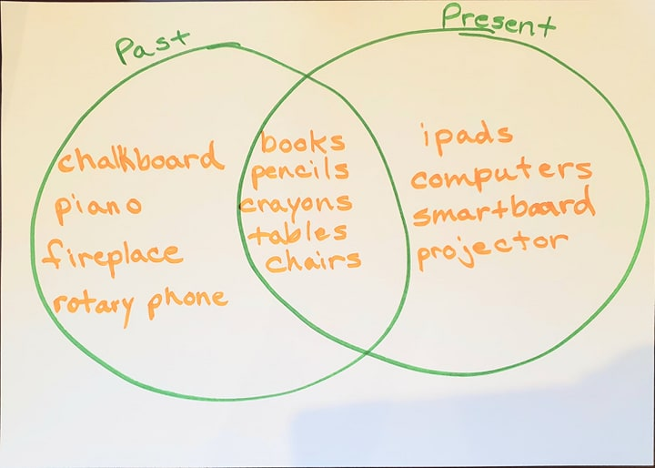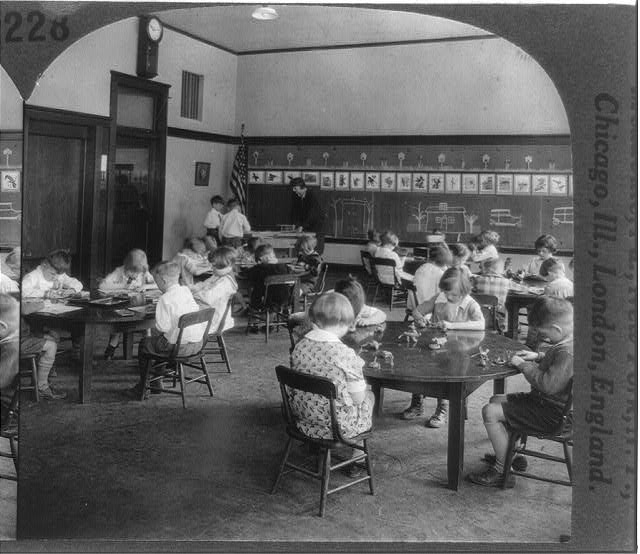Summary
Students will explore and explain how primary sources can help us learn about history. The class will use photos from approximately 100 years ago to discover how past classrooms compare with today’s classrooms. Students will then explore possibilities for future classrooms and draw their vision of how they think students will learn 100 years from now.
Essential Question(s)
How do clues from pictures help us understand the lives of people in the past and present? How were schools different in the past, and why have they changed over time?
Snapshot
Engage
Students create an anchor chart together as they discuss what helps make learning happen in their classroom.
Explore
Using primary source photos of classrooms from approximately 100 years ago, students use the Collective Brain Dump strategy to compare and contrast classrooms from today and the past.
Explain
During a class discussion, students share with partners what they learned from viewing pictures of schools from long ago and pictures of today’s classrooms. They collaboratively create a Venn diagram capturing these comparisons. Pertinent vocabulary is introduced and added to the class word wall or chart.
Extend
Students draw a picture or diagram showing what tools students and teachers will use in future classrooms.
Evaluate
Using the Triangle-Square-Circle strategy, students answer questions about schools in the past, present, and future.
Materials
Lesson Slides (attached)
Pictures of Classrooms in the Past (attached)
Pictures of Classrooms in the Present (attached)
School of the Future handout (attached; one per student)
Anchor chart paper
Engage
Start by asking students to think about what items in their classroom help make learning happen. Have them turn and talk with a partner to share their ideas. Then have a whole class discussion and create a class anchor chart to record students’ answers. If needed, guide students by asking them to think about specific tools they use every day.
Explore
Display slide 3 of the attached Lesson Slides, and ask students to think about these essential questions:
How do clues from pictures help us understand the lives of people in the past and present?
How were schools different in the past, and why have they changed over time?
Display slide 4, and explain how photos of classrooms from the past are examples of primary sources. Then introduce to students the old classroom photos on slides 5–8. You also can print out the attached Pictures of Classrooms in the Past and have students pass the pictures around.
You may also want to show students the websites where the photos were retrieved (or you can wait and do this later in the lesson if it will distract your students from the content at this time). Display slide 9, and ask students to continue thinking about the essential questions introduced earlier in the lesson.
Have students share their ideas with an Elbow Partner or in small groups. When groups are finished sharing with one another, introduce the class to the Collective Brain Dump strategy. Have each group share their knowledge with the whole class in a Collective Brain Dump.
As the class shares out, record their ideas on a whiteboard space or on chart paper to create a whole-class product.
Explain
Show the class a few typical first- or second-grade classroom pictures from the present day. You can use the pictures provided on slides 10–13 or take your own. You also can print out the attached Pictures of Classrooms in the Present and have students pass the pictures around.
Next, introduce students to the Partner Speaks strategy, which helps students practice active listening, and gives voice to students who might otherwise not share their thoughts.
Invite students to participate in a Partner Speaks activity. During this activity, students should work in pairs to share what they learned about past and present schools from the pictures. The anchor chart, vocabulary list, and pictures from the previous sections of the lesson should be visually accessible so that students can use them as prompts if needed.
After students have had enough time to share with their partner, gather the class together and display slide 14. Explain what a Venn diagram is, and tell students that they will create one as a class to compare and contrast things that are different and the same in today’s schools and those of the past.
Create a large Venn diagram on poster paper or a whiteboard space. Have students take turns as each pair shares one thing their partner told them, rather than their own ideas, with the whole class. As each pair shares, have the class decide where you will write it on the Venn diagram. If attention wanes as the discussion happens, take a break and come back to it.
Below is a rough draft of a sample Venn diagram. More details can and should be added to the whole-class product as each pair shares.

Extend
Display slide 15, and pose this question to the class: What will classrooms look like 100 years from now?
Pass out the attached School of the Future handout, and have each student draw a picture or diagram showing what tools students and teachers will use 100 years from now to help them learn.
Interview students about what they are drawing and writing, and help students to write captions or titles for their pictures.
Evaluate
Display slide 16, and have students use the Triangle-Square-Circle strategy to draw or write their responses to the following questions:
Triangle: How were schools different in the past?
Square: Why have schools changed over time?
Circle: What do you still wonder about these changes? What questions do you have?
Display slide 17, and use students’ responses to the Triangle-Square-Circle activity to revisit this lesson’s essential questions:
How do clues from pictures help us understand the lives of people in the past and present?
How were schools different in the past, and why have they changed over time?
Bring the class together and have a class discussion, asking the following:
Have we answered our essential questions?
How did we do this?
Did using primary sources help us to find the information we needed?
Do you think using primary sources is a good way to learn about the past and present?
How could we find the answers to the questions you wrote on your circles?
Resources
Keystone View Company. (1927). First Grade at Work [Photograph]. Library of Congress. https://www.loc.gov/item/97505974/
K20 Center. (n.d.). Anchor Charts. Strategies. https://learn.k20center.ou.edu/strategy/58
K20 Center. (n.d.). Collective Brain Dump. Strategies. https://learn.k20center.ou.edu/strategy/111
K20 Center. (n.d.). Elbow Partners. Strategies. https://learn.k20center.ou.edu/strategy/116
K20 Center. (n.d.). Partner Speaks. Strategies. https://learn.k20center.ou.edu/strategy/62
K20 Center. (n.d.). Triangle-Square-Circle. Strategies. https://learn.k20center.ou.edu/strategy/65


